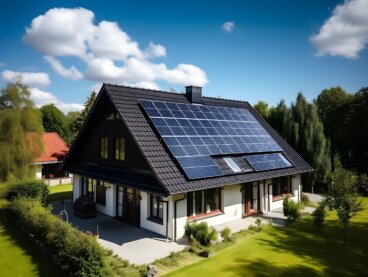Efficient Windows: Everything You Need to Know About Energy Star Certification

When it comes to home renovations, replacing old windows and doors is a great way to improve energy efficiency, lower greenhouse gas emissions, and reduce bills. Keep reading to learn about Energy Star certification and prepare to use the best materials in your home.
With a better understanding of energy impact, consumers can make informed decisions when selecting the right windows for their needs. This can result in significant savings in lighting costs and reduced carbon footprint. Learning how to choose Energy Star-rated products becomes critical.
You may also be interested in: A Few Tips to Lower Your Electricity Bill
What is Energy Star certification and how does it work?
Energy Star is a certification that helps people identify products that meet high energy efficiency standards by means of a blue seal. This initiative is part of an international program led by the U.S. Environmental Protection Agency (EPA) which is an ally in investing in efficient windows and doors.
The mission of these blue seals is to reduce greenhouse gas emissions by helping consumers make informed purchasing decisions. Products that earn Energy Star certification must meet strict technical specifications for energy performance, as well as other criteria related to quality, features, and benefits.
This valuable rating is carried by a wide range of products, such as household appliances, lighting equipment, and heating appliances. What many people don’t know, however, is that it also applies to replacement windows and doors; as long as their designs are energy efficient and prevent heat or cold loss in homes and buildings.

5 benefits of Energy Star-certified windows
Products with this rating go beyond simply reducing energy costs. This is because, in addition to creating a welcoming environment, they also increase the value of homes. Here are other benefits homeowners can enjoy by investing in energy-efficient models:
1. Reduce gas emissions
Efficient windows can help reduce greenhouse gas emissions and combat climate change. According to Natural Resources Canada, windows and doors can account for up to 25% of total heat loss in the home. This means that upgrading to more efficient models can significantly reduce environmental impact.
2. Create a more comfortable and healthy indoor environment

Energy Star-certified energy-saving units can help regulate the temperature inside a home, making it more comfortable and reducing the load on heating and cooling systems.
In addition, modern windows can reduce the amount of condensation and drafts in the home, improving indoor air quality and reducing the risk of mold growth. This is a benefit that helps improve people’s well-being.
Keep reading: A Home With a Lovely View is Good For Your Mental Health
3. Increase the value of the home
Energy-efficient upgrades are becoming increasingly popular among Canadian homebuyers because having certified products can significantly increase the value of a home.
According to a study conducted by the Appraisal Institute of Canada, energy efficiency upgrades can increase the value of a home by as much as 5-8%. Therefore, it’s an investment that will benefit your equity in the future
4. Access rebates and incentives
The Canadian government offers rebates at the federal level to help homeowners upgrade to energy-efficient products. For example, the Canada Greener Homes Grant provides rebates of up to $5,000 for homeowners who install Energy Star-certified windows and doors
5. Lower maintenance and replacement costs
Modern window units are often built with higher-quality materials and are designed to last longer than less efficient products. This means that owners can save money on maintenance and replacement costs in the long run.
What must a window have to meet Energy Star certification?
In Canada, this rating for windows and doors is based on three key measurements. Keeping them in mind will help you purchase excellent quality models.
- Thermal transmittance (U-Factor): This measures the rate of heat transfer through the window. The lower the U-Factor, the better the insulation against heat loss. In Canada, Energy Star windows must have a thermal transmittance of 1.4 or less.
- Solar heat gain coefficient (SHGC): Measures how much solar heat is transmitted through the window. The lower the SHGC, the less solar heat is transmitted, which is beneficial when air conditioning is needed in the summer. In Canada, Energy Star-certified windows must come with an SHGC of 0.4 or lower.
- Energy Rating (ER): This is a measure of the overall energy performance of the window, taking into account both the U-Value and SHGC. Energy Star windows in Canada must have an energy rating of 34 or higher.
Final points to consider when buying energy-efficient windows
There are other factors to consider when buying energy-efficient windows. For example, vinyl and fiberglass frames are generally more optimal than aluminum, and double or triple-glazed windows are better than single-glazed windows.
In conclusion, Energy Star certification in Canada is an excellent way to identify products that meet energy-efficiency standards. This blue seal can help you make informed purchasing decisions, reduce your environmental impact, and save money on energy costs in the long run.
All cited sources were thoroughly reviewed by our team to ensure their quality, reliability, currency, and validity. The bibliography of this article was considered reliable and of academic or scientific accuracy.
- Adomatis, S. (2018). A Guide to the Residential Green and Energy Efficient Addendum. Appraisal Institute of Canada. https://www.appraisalinstitute.org/assets/1/29/A_Guide_to_Res_Green_EE_Addendu m_%28002%29.pdf
- Energy Star. Residential Windows, Doors and Skylights. What makes it ENERGY STAR?. (Recuperado el 12/04/2023). https://www.energystar.gov/products/residential_windows_doors_and_skylights/key _product_criteria
- Natural Resources Canada. Keeping The Heat In - Section 8: Upgrading windows and exterior doors. (Recuperado el 12/04/2023). https://natural- resources.canada.ca/energy-efficiency/homes/make-your-home-more-energy- efficient/keeping-the-heat/section-8-upgrading-windows-and-exterior-doors/15643
- Natural Resources Canada. Canada Greener Homes Grant Initiative. (Recuperado el 12/04/2023). https://natural-resources.canada.ca/energy-efficiency/homes/canada- greener-homes-initiative/canada-greener-homes-grant/canada-greener-homes- grant/23441








